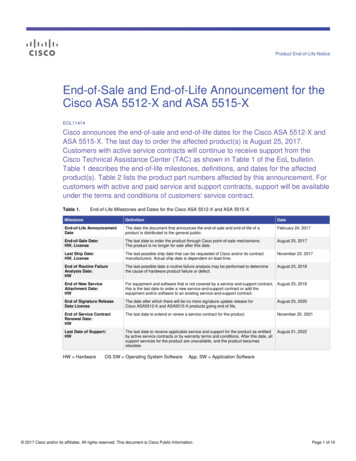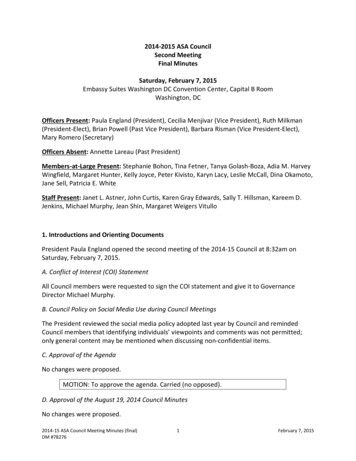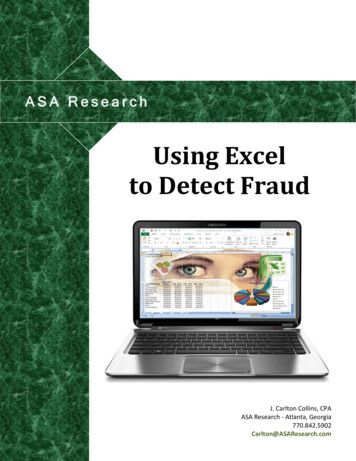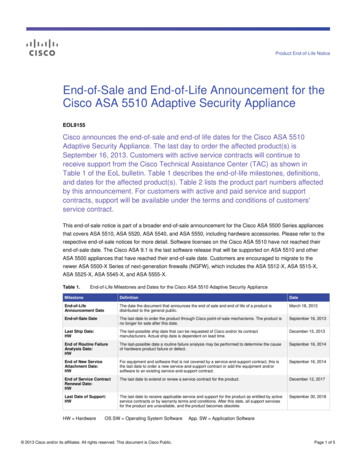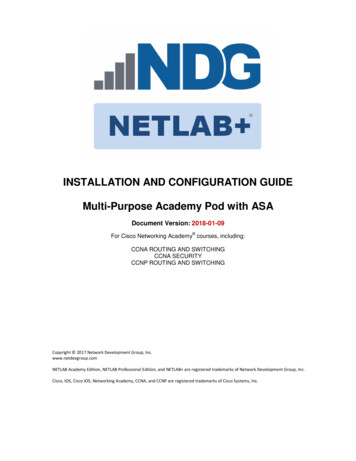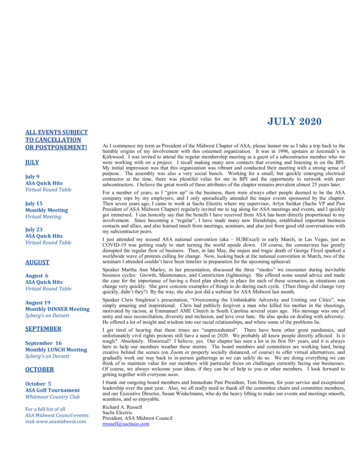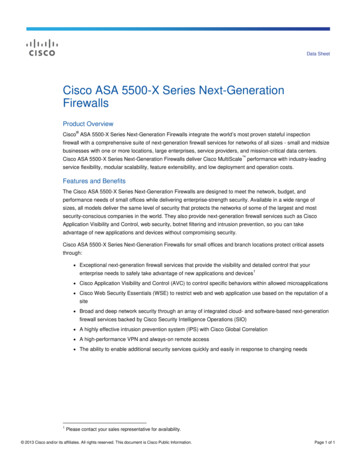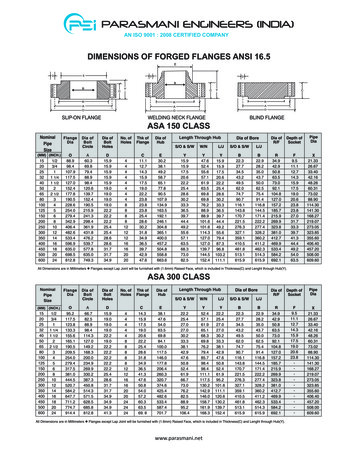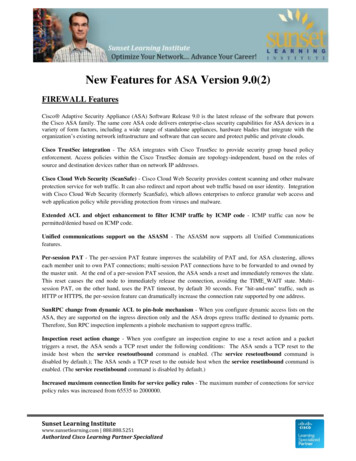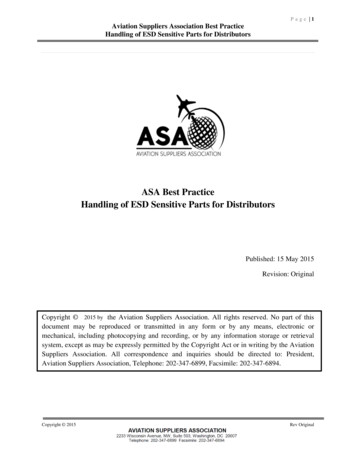
Transcription
P a g e 1Aviation Suppliers Association Best PracticeHandling of ESD Sensitive Parts for DistributorsASA Best PracticeHandling of ESD Sensitive Parts for DistributorsPublished: 15 May 2015Revision: Original2015 byCopyright 2014by the Aviation Suppliers Association. All rights reserved. No part of thisdocument may be reproduced or transmitted in any form or by any means, electronic ormechanical, including photocopying and recording, or by any information storage or retrievalsystem, except as may be expressly permitted by the Copyright Act or in writing by the AviationSuppliers Association. All correspondence and inquiries should be directed to: President,Aviation Suppliers Association, Telephone: 202-347-6899, Facsimile: 202-347-6894.Copyright 2015Rev Original
P a g e 2Aviation Suppliers Association Best PracticeHandling of ESD Sensitive Parts for DistributorsTABLE OF CONTENTSTITLEPAGETitle Page1Table of Contents2Purpose and Audience3Legal Effect of this Guidance3Related Documents3Background3Selection of Equipment for an ESD Protected Area (EPA) 4Common EPA Characteristics5Determining the Continued Integrity of the EPA5Packaging7Handling, itional Resource Documents9Figure 1: Typical Simple EPA10Figure 2: Typical Ground sources11Figure 3: Typical Continuous Monitoring EPA12Copyright 2015Rev Original
P a g e 3Aviation Suppliers Association Best PracticeHandling of ESD Sensitive Parts for DistributorsPurpose and AudienceThis document is intended to be useful for Distributors which handle aircraft parts susceptible todamage from Electro Static Discharge (ESD). The guidance in this document is meant to helpprevent such persons from accidentally damaging ESD sensitive parts during handling,inspecting, storing, receiving or shipping operations. This guidance is bound by the assumptionthat Distributors will not be performing manufacturing operations (such as assembly, installationor building up) or maintenance operations (such as removing and replacing components, testing,or adjusting) ESD sensitive parts. Those regulated manufacturing and maintenance operationsmay typically require additional equipment and procedures not contained herein.Legal Effect of this GuidanceThis guidance represents recommended practices, based upon common industry practices thathave been found to be successful. It does not represent a regulation or a requirement. TheAviation Suppliers Association does not require any company to adhere to this recommendedguidance, and does not recommend that any company require a business partner to adhere to thisrecommended guidance.Related Documentsa) ATA Spec 300, Specification for Packaging of Airline SuppliesBackgroundFor many people, static electricity is little more than the shock experienced when touching ametal doorknob after walking across a carpeted room. However, static electricity has been aserious industrial problem for centuries. As early as the 1400’s, European and Caribbean fortswere using static control procedures and devices to prevent electrostatic discharge ignition ofblack powder stores. By the 1860’s, paper mills throughout the US employed basic grounding,flame ionization techniques, and steam drums to dissipate static electricity from the paper web asit progressed through the drying process.The age of electronics brought with it new problems associated with static electricity andelectrostatic discharge. Due to electronic devices becoming faster and smaller, their sensitivity toESD increased. Today, ESD impacts productivity and product reliability in virtually every aspectCopyright 2015Rev Original
P a g e 4Aviation Suppliers Association Best PracticeHandling of ESD Sensitive Parts for Distributorsof today’s electronics environment, and in fact for all market segments, studies have estimatedthat up to 60% of device failures are ESD caused.1A major factor contributing to ESD damage is lack of awareness of the ease in which damageoccurs. For example, the average person can feel a discharge on a doorknob if it is greater than3500 volts; hear the discharge if it is greater than 5000 volts, and see it if it is greater than 8000volts. By comparison, damage to integrated circuits occurs at fractions of those voltages. Thismeans that the person imparting the damage will not have felt, seen or heard the discharge, andbecause of this we must always assume we can potentially cause ESD damage unless thosecharges are properly grounded, as for example, in accordance with this Best Practice.ESD sensitive parts that have been damaged could manifest such damage in one of several waysupon being installed on the aircraft:a) Immediate failure of the part when the component/system is tested.b) Premature failure of the part. E.g. the part fails much sooner than its designed Mean TimeBetween Failure (MTBF) figure.c) The part or its next higher assembly exhibits intermittent or random failures.Depending on the part’s criticality, ESD damage can affect safety, flight delays or cancellations,system reliability, create chronic or rogue parts, and increased maintenance costs.Selection of Equipment for an ESD Protected Area (EPA)Selection of the equipment that will make up the EPA should consist of any of the followingconfigurations:A. Continuous Monitoring Workstation (Figure 3). The advantage of this setup is that itcontinuously monitors the resistance of the operator and work surface groundconnections and displays a visual and/or audible alarm if a problem occurs with theaforementioned. It typically consists of the Monitor, Dual Conductor Wrist Bands, WristBand Chords, grounding connection, and Table-top Conductive/Dissipative WorkSurface Mat. All EPA components should be installed in accordance with themanufacturer’s instructions.B. Simple EPA (Figure 1). Consists of an ESD Wrist Strap and chord, Wrist Band Chords,grounding connection, and Table-top Conductive/Dissipative Work Surface Mat. AllEPA components should be installed in accordance with the manufacturer’s instructions.Copyright 2015Rev Original
P a g e 5Aviation Suppliers Association Best PracticeHandling of ESD Sensitive Parts for DistributorsC. Additional EPA Components: Users may optionally choose to have additional Mats orWrist Straps to support additional employees working simultaneously. All EPAcomponents should be installed in accordance with the manufacturer’s instructions.D. Selection of a ground for the EPA must be in accordance with the manufacturer’sinstructions. Examples of such grounds are included in Figure 2.Common EPA CharacteristicsA. Segregated area: A dedicated area should be set aside to set up the EPA to be usedexclusively for this purpose. This will help ensure the equipment is maintained, keptclean, and the connections are not broken.B. The EPA should include signage denoting its intended use. Examples include “ESDProtected Area”, “ESD Work Station”, or “ESD Inspection Area”.C. Cleanliness: In order to eliminate sources of static, the EPA should remain free of anynon-EPA related items such as, but not limited to coffee cups, food wrappers, beverages,reading material, radio’s, and personal gear such as purses and backpacks. In addition,the EPA should be periodically cleaned as recommended by the ESD equipmentmanufacturer.Determining the Continued integrity of the EPAThe user should have a method to demonstrate the continued integrity of the EPA; that it is ableto perform its intended purpose of electrically grounding the static charges on the employeebefore handling the ESD sensitive parts. Note that this in not calibration.As a point of reference, per Grounding/Equipotential Bonding Requirements of the ANSI/ESDS20.20-2007 standard “Protection of Electrical and Electronic Pars, Assemblies and Equipment(Excluding Electrically Initiated Explosive Devices”; the equipment grounding conductor of thegrounding/bonding system should have a limit less than 1.0 ohm impedance. The measurementof ohm impedance of the grounding conductor can be verified using a standard electricalmultimeter. The inclusion of the multimeter into a distributors calibrated tool system may beconsidered as it is measuring a variable within the overall EPA.Copyright 2015Rev Original
P a g e 6Aviation Suppliers Association Best PracticeHandling of ESD Sensitive Parts for DistributorsWhile the connection to electrical ground (in accordance with the manufacturer’s instructions) isamong the most critical steps in setting up the EPA, once accomplished it is typically fixed andpermanent (see Figure 2: Typical ground sources). However, the level of effectiveness of theelectrical ground should be periodically verified by measuring the level of ohm impedance (seeabove). While this verification is not a “calibration”, consideration may be given to record theresults of the measurement/verification, providing evidence of the effectiveness of the EPAelectrical ground. Experience has shown however, that the most problem-prone component of theEPA tends to be the electrical continuity between the human-wristband-wristband chordcombinations. Factors that affect this integrity include excessive hair between the human andwristband, dirt, minor corrosion of the metal connections, or loss of elasticity/tightness of thewrist band.A. Continuous Monitoring Workstation: As the name implies, the integrity of this type ofEPA system is continuously monitored and the workstation will display an alarm ifproblems arise with the connections of the EPA. There is no additional need for separateTesters.B. Simple EPA: The user should have a method to determine the integrity of the HumanWristband-Wristband Chord combination. Commonly available Testers exist for thispurpose. For facilities where the EPA is not used on a daily basis, it would be typical totest integrity before the first use on each day on which it is used (but testing would not beperformed on the days when it is not used).C. Documenting Results: The user may implement a method to record continued integritytest results. Some, but not all, facilities keep a log of this information. Typically, a logfor recording test results would contain the date, employee identification (e.g. name,number, etc.), and results of the test. Typically, the first user of the day should make thisrecord once daily before use. On days where the equipment is not used, the record is notrequired Continuous Monitoring Workstation: The user should test the alarm by purposelyeither lifting off the wristband, or breaking any of the quick connections of theworkstation. Simple EPA: Record the results of the Tester.Copyright 2015Rev Original
P a g e 7Aviation Suppliers Association Best PracticeHandling of ESD Sensitive Parts for DistributorsPackagingWhen packaging ESD sensitive parts, consideration is given to one of three types of parts; Pieceparts (such as IC Chips, Transistors), Circuit Boards, or LRU’s (Line Replaceable Units,commonly referred to as Rotables or appliances). ATA Specification 300offers simple additionalguidance.CAUTION: Staples should not be used to seal any ESD-protective packaging or used to attachdocuments as this may compromise the ESD protection.A. Piece Parts: The Leads for these parts should be embedded in ESD protective foam,typically black. The parts are then placed in static shielding/dissipative bags (typicallygray or silver, not pink which is not recommended due to its limited protectiveproperties; they do not shield from Electrostatic Fields1). The parts may then be placedin standard protective shipping packaging.B. Circuit Cards: Cards are placed in static shielding/dissipative bags (typically gray orsilver, not pink which is not recommended due to its limited protective properties; theydo not shield from Electrostatic Fields1). The cards may then be placed in standardprotective shipping packaging.C. LRU’s: Assure black ESD Protective Caps are placed over the connector pins. Once theLRU has these caps in place, the part can be handled outside of an EPA without fear ofinducing ESD damage. With the ESD caps in place, placing the LRU in staticshielding/dissipative bags is not required2. It may then be placed in standard protectiveshipping packaging.D. LABELING: ESD labels should be affixed to the outside of packages or containers toapprise handlers of the ESD sensitive nature of its contents.Handling, WarehousingWith the exception of being placed in the final standard shipping container/package, once ESDsensitive parts have been protected as described in the ‘Packaging’ paragraph, the parts may besafely handled outside of an EPA.Copyright 2015Rev Original
P a g e 8Aviation Suppliers Association Best PracticeHandling of ESD Sensitive Parts for DistributorsTrainingPersons who handle ESD sensitive parts should have the following topics documented in theirtraining files:A.B.C.D.What is ESD?Sources of static chargesUse and care of the EPAPackagingCalibrationEquipment such as, but not limited to, Wristband-Chord Testers typically require periodiccalibration in accordance with the manufacturer’s instructions, and should be placed on thedistributor’s calibration program and documented in its Quality System.DocumentationThe Distributor should maintain files of the manufacturer’s instructions regarding the equipmentcontained in the EPA. This serves to verify for employees as well as auditors conformity withinstallation instructions. In addition, equipment documentation such as may exist with certainmodels of Continuous Monitoring Workstations which state that calibration is not required(except for factory settings), shall also be filed and presented for employees or auditors asneeded.1ESD Control Handbook, Static Control Measures; 3M Corporation.2ATA Specification 300 figure 6-2.1Copyright 2015Rev Original
P a g e 9Aviation Suppliers Association Best PracticeHandling of ESD Sensitive Parts for DistributorsAdditional Resource DocumentsThe following documents are provided for further reference and additional information. Somedocuments listed below may be canceled/obsolete.ANSI/ESD S20.20-2007, “Protection of Electrical and Electronic Parts, Assemblies andEquipment (Excluding Electrically Initiated Explosive Devices”MIL-DTL-117, “Bags, Sleeves and Tubing – Interior Packaging”MIL-PRF-81705, “Electronic and Electrical Equipment, Accessories, and Provisional Items(Repair parts): Packaging of”MIL-STD-1686, “Electrostatic Discharge Control Program for Protection of Electrical andElectronic Parts, Assemblies and Equipment (Excluding Electrically Initiated ExplosiveDevices)”MIL-HDBK-263, “Electrostatic Discharge Control Handbook for Protection of Electrical andElectronic parts, Assemblies, and Equipment (Excluding Electrically-Initiated ExplosiveDevices)”MIL-PRF-87893, “Workstations, Electrostatic Discharge (ESD) Control”Copyright 2015Rev Original
P a g e 10Aviation Suppliers Association Best PracticeHandling of ESD Sensitive Parts for DistributorsFigure 1: Typical Simple EPATo Ground,See figure 2ESD MatPart to beinspectedESD Wrist Strapand chordTypical Wrist Strapand chord testerCopyright 2015Rev Original
P a g e 11Aviation Suppliers Association Best PracticeHandling of ESD Sensitive Parts for DistributorsFigure 2: Typical ground sourcesFrom MatCopyright 2015Rev Original
P a g e 12Aviation Suppliers Association Best PracticeHandling of ESD Sensitive Parts for DistributorsFigure 3: Typical Continuous Monitoring EPAMatGroundMonitorMonitor PoweradaptorDual Conductor wrist strapchord plugs‐in hereCopyright 2015Rev Original
May 15, 2015 · inducing ESD damage. With the ESD caps in place, placing the LRU in static shielding/dissipative bags is not required2. It may then be placed in standard protective shipping packaging. D. LABELING: ESD labels should be affixed to the outside of packages or containers to apprise handlers of the ESD sensitive nature of its contents.File Size: 378KB
